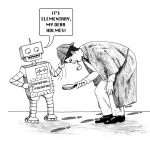The Neutrino Hunter. Swarthmore College Bulletin, January 2009, p. 38.
A profile of Janet Conrad, an extroverted physicist chasing the most introverted of all particles: the neutrino. The article also leaps fearlessly into the debate over Larry Summers’ remarks in 2005 about why women are underrepresented in certain sciences.
Free Fall. New Scientist, 10 February 2007.
A team of physicists at Stanford prepares a new experiment to measure the force of gravity on an atomic scale. Think of it as a cross between quantum physics and Galileo’s experiment of dropping cannonballs off the Tower of Pisa. The goal: confirm some never-before-tested predictions of Einstein’s theory of general relativity, or else discover new physics.
When God Plays Dice. New Scientist, 4 November 2006.
Twistors, a mathematical gadget invented by Roger Penrose in the 1960s, are now dramatically simplifying the computation of processes that go on in particle colliders. Twistor theory, which was the best candidate for a “theory of everything” before physicists dumped it in favor of string theory, may turn out to be the right way to look at spacetime after all.
Super Computer vs. Particle Accelerator: The Great Physics Heavyweights. New Scientist, 13 August 2005.
Once you get past the overblown prize-fight metaphor (sorry, my editors made me do it), this is an article about lattice QCD (quantum chromodynamics), which is a way to make the equations of particle physics work in a universe divided into pixels. This is perfect, of course, for computers. Physicists have now managed to use lattice QCD to predict the results of certain experiments to within 1 or 2 percent, before the experimenters actually announced their results.
Spinning Into Posterity. SIAM News, March 2003.
This year marks the 75th anniversary of one of the most fundamental equations in physics: Dirac’s equation for the electron, which explained the phenomenon of electron spin and predicted the existence of antimatter.
A Flapping of Wings, with sidebar: It’s a Bird, It’s a Plane, It’s a… Spy? Science, 23 March 2012, 1430-1433.
We all know that the Wright brothers invented the airplane and enabled humans to fly. But the age-old dream of flying like a bird — flapping wings and all — has remained more elusive. Recent advances in ornithopters have made made birdlike flight (and birdlike landing, which is harder) much more feasible, at least for robots. This could lead to much more maneuverable (and better disguised) unmanned aerial vehicles.
Operation clean-up. New Scientist, 29 October 2011.
Shortly after the Deepwater Horizon oil spill, the X Prize Foundation announced a competition to develop new ways to remove oil slicks. The winners more than tripled the speed of any previous mechanical recovery system, and proved conclusively that chemical dispersants are not the only way to clean an ocean.
Fill ‘er up with … Lithium. SIAM News, March 2010.
Batteries that can discharge and recharge quickly are crucial for the future of electric and hybrid cars. Martin Bazant uses the Cahn-Hilliard equations to explain how lithium-ion batteries work, and perhaps to make them work faster.





